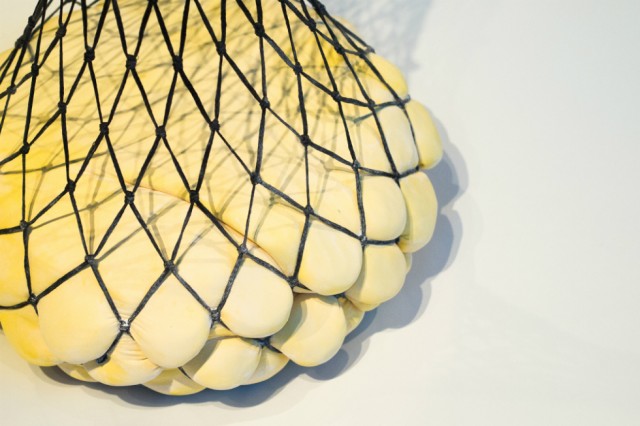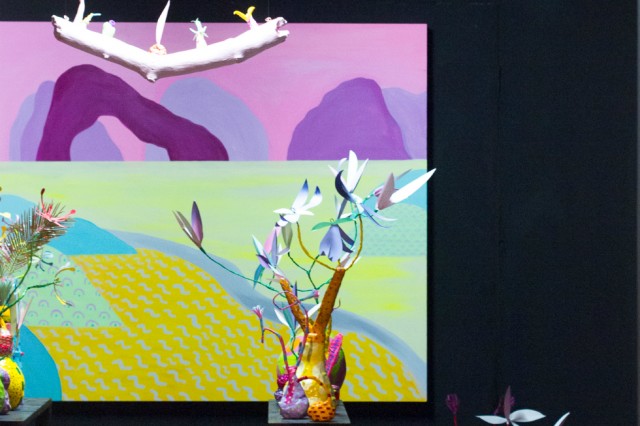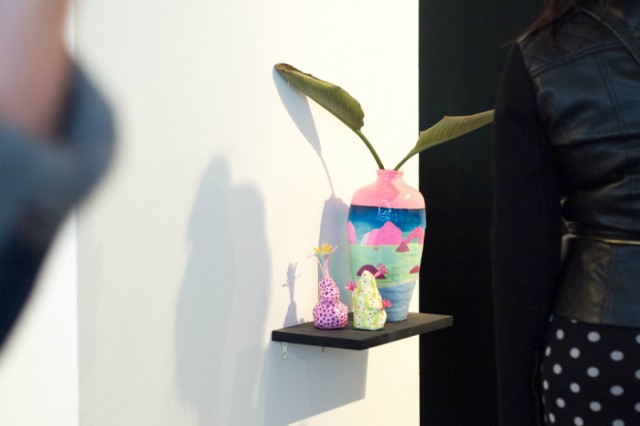Should Female Art Exist? Clam Jam Q & A

Maggie Matić meets the women behind Clam Jam — ‘An exhibition of female art’ — to grill them about angering feminists, playing on cliché, and battling a persistent gender imbalance in the contemporary art world…
The text accompanying the The Royal Standard’s current exhibition, Clam Jam, begins with a quote from artist Sigalit Landau:
‘There is such a thing as woman art. And I’m not sure having it all together in one place is right for today. It is a touch artificial, and maybe creates an imbalanced experience.’
The quote comes from a 2009 article addressing conflicting ideas about all-female art shows, which arose during a time when institutions were actively striving to acquire and exhibit more work by women. Since then, there has been a marked improvement in the representation of women in national collections. However, it remains the case that there are more female than male art school graduates, yet gender representation within said collections, commercial galleries and exhibitions worldwide still fails to reflect this.
30 years on from the famous feminist intervention of the Guerilla Girls, and having had 40 years to consider Linda Nochlin’s query as to why there have been no great female artists, it appears we still have a way to go in redressing the art world’s gender imbalance. Precisely how we may strive to do so is an issue that continues to bewilder those at the helm. As Landau’s quote illustrates, great sensitivity is required in the treatment of art made by women, and the debate surrounding all-female art exhibitions is still alive and kicking.
Clam Jam, a group show featuring work from seven emerging female artists, opened at The Royal Standard earlier this month. Guests at the private view were met by Claudia Dance-Wells’s heavy, protruding sculptures, Chloe Mcclellan’s delicate yet resolute works on paper, and the glittering floral arrangements of Sadie Williams. They were also greeted with a cocktail and a canapé — the latter modelled on a vagina. The gallery commissioned a female designer — Holly Bagnall — to create the unique vulva/clam logo which graced the poster campaign in the run up to the show; sparking an important conversation about ‘woman art’ and how it should be approached.
I met Ellie Barrett, one of the curator/directors at The Royal Standard, as well as Claudia Dance-Wells and Chloe McClellan, two of the artist whose work features in Clam Jam, to find out more about the process of putting together an all-female art show…

The Double Negative: What motivated you to host an all-female show at The Royal Standard?
Ellie Barrett: Clam Jam came from going to a lot of shows and noticing that there was a lot of female work, an awful lot. There’s a lot of girls, especially at art school, that tends to be the case. And that’s just starting to show in terms of who is exhibiting where, I think.
Yes, it’s noted that there’s a discrepancy between the percentage of art school graduates who are female and the representation of women artists in the art world. It’s interesting that you see that starting to balance out.
EB: I think so, only just. I also noticed though, when I was looking at these shows and what was being exhibited, it seemed that the theme of the show had led the curators to choose female artists. The themes of the shows I am referring to were delicate and domestic, and so the work was all female, although there was no recognition of it being female. I thought this was interesting. My reaction to this was, what if there was a show where the only branding of it was: ‘This is female art’; and that was all we presented it as. No theme, no specific enquiry, just an exhibition of female art.
You mentioned that you had scepticism and criticism along the way…
EB: We did, and we expected to. The whole thing was about treading a line, and we have been careful to tread that barrier in everything we have done with Clam Jam, in that we wanted to make sure it was playful and nobody took it too seriously, but at the same time not being flippant about what we were doing, and not making a joke about presenting female work.
So was Clam Jam a feminist statement?
EB: I didn’t want to brand it with any feminist banner. I didn’t want it to take on the message: ‘Oh, here’s opportunities for female artists’; because these opportunities already exist, and they are beginning to exist more and more.

People will probably assume that this is a feminist statement. I know I did.
EB: Yes they have.
Perhaps that’s where the criticism creeps in, because people will look at Clam Jam from a feminist perspective, and will see that you are creating this isolated space for women’s art. But you’re saying it was more loose than that. Rather than adopting a theme, it was simply agreed that all the women in the show would be female, in the same way that all the artists in a sculpture show would be sculptors.
EB: Yes, exactly.
That’s interesting. This is why most institutions would host an all-female show — to make a feminist statement. It seems hard to separate the two.
EB: Well, one of the things which looked into was the Pompidou [Centre, Paris], who in 2009, rehung their entire permanent collection so it was only female artists exhibiting, and called it Elles… A lot of the artists who agreed to do it were still uneasy about it, saying that it promotes the idea of ‘woman art’, which takes it away from art and separates the genders. They expressed that this isn’t useful but is actually damaging. The curator of the show was almost flippant about it, and she said it was just a risk — I use this quote in our press release. So even in that show where artists contributed, there were contrasting opinions, and people were treading that line between whether this is a good thing, whether it means anything, or will this isolate female art?
One of the artists that we approached to be in the show said that this was a brave but meaningless thing to do. A question I have become interested in while researching around the show was questioning whether female art exists, and should it?
Some people at the opening were saying that if it wasn’t made clear that it was an all-female show, that you wouldn’t know by looking at the work whether it was made by a particular gender. Others were saying they thought it was a ‘girly’ show, and they felt a lot of the work addressed themes of femininity and womanhood.
EB: I actually think it is quite a girly show.
Claudia Dance-Wells: I think it is a very girly show.
EB: It’s funny, because we didn’t intend to make it girly, but at the same time, I was aware that you can’t ever say that a work doesn’t deal with gender. It does deal with gender because it’s made by women. We make the work we make because of our gender to an extent.

Perhaps it’s not a problem that it’s a girly show. People are cautious about using the word ‘girly’, because there does exist this fear of putting women’s art in a special vacuum, which is why a show like this can be controversial.
EB: We did have one artist get very angry with us. Really angry. To the extent that she said: “Not only will I not be participating, but I think you should consider not going ahead with this at all”. For that very reason — she felt that we were taking women’s art and putting it where it shouldn’t be.
In an isolated vacuum of ‘woman art’ that gets branded as ‘girly’.
EB: Exactly.
As artists who did agree to participate in the show, what is your stance on this issue?
CD-W: I think it is still really important to talk about women’s art. Especially since I moved to Leeds — there are so many more men in Leeds, and there is a lot of all-male shows that happen. This has already become a bit of a problem for me, to be an artist in that place. It is still an issue, and even if Clam Jam isn’t to everyone’s ideal of what feminism should be, it is getting people talking, which is ultimately what needs to happen with feminism. It needs to be a little bit controversial in order to make people speak about it and remember that it’s there.
EB: Also when I say that Clam Jam isn’t necessarily about feminism, I don’t want it to not be about feminism.
Without all-female shows, people might not think about the fact that there are often all-male shows; but this just goes under the radar because it’s the norm. The debate centres on whether there is a space for all-female shows. In that sense, I suppose there is, because it throws light on these persisting problems.
Chloe Mcclellan: Yes. I totally agree with Claudia. When Ellie first spoke to me about the show, I was really excited to work with the girls who she said were going to be involved. When I look back on the shows that I have done in the past year, very often you are the only woman artist, and so I was looking forward to working with women. This is precisely the problem though, like you said, an all-male show — people wouldn’t even bat an eyelid, which is incredibly frustrating.

EB: We could have picked a theme, or called it a sculpture show, and nobody would have had a problem with it. But what’s the point? That isn’t what it was. Calling it an all-female exhibition does more I think, it asks more questions. But this is also what has caused problems.
CD-W: It got people talking!
There is obviously is a space for all-female shows; the problem perhaps is that we shouldn’t require a space. You shouldn’t need to do an all-female exhibition, but you do, and so perhaps you should. It’s like the statement: ‘I need feminism because I shouldn’t’.
Something I have personally found slightly problematic is the branding of Clam Jam: the name, the imagery, the vagina-themed canapés etc. But I can also see how it acts like a caricature. It’s playful.
EB: I felt that it had to be playful. To get the right output of being gently inquisitive, and the artwork being as important as the framework, I think it had to be. A female did the graphic design for us, and we gave her free reign to do whatever she wanted, and this is what she came back with. She was worried it was too far and was nervous to show us what she made, but I said it has to go too far and have that cartoon quality to it.
It looks great! However, I think a problem arises when you introduce imagery of female genitals. You could be seen to using the vagina as the site of ‘female-ness’, tying the works to the fact that their maker has a vagina; which from a contemporary feminist perspective can raise certain concerns about outdated gender essentialist ideas.
EB: I can see how there is that conflict there.
CD-W: But that is how it has been used — it’s a cliché.
EB: I like how you used the word caricature, that’s exactly how we intended it.
You are unapologetic in being playful.
EB: Totally. I felt that the work and the marketing needed to bounce off one another, they needed to contrast. I knew I wanted to say that this is female, and I wanted to be really overt and cartoonish, to allow the work to stand on its own. I wanted people to see the branding as really extreme so that they could read the work separately, rather than reading it as anything to do with the body.

I think the branding did move into the flippant zone, which I found a little insensitive in some ways. But it did get people talking. For me, the canapés, the drinks, the branding and the hype in the run-up to the opening stood aside when I experienced the space and the work. The show said: ‘No, but in all seriousness, look at this amazing art made by women’; which balanced it out in the nick of time for me.
EB: What you’ve said there represents the whole show — that’s exactly what we wanted. Making sure that we were flippant to some extent, because otherwise people get bogged down with being too serious and then this gets criticised. We wanted it to be fun but serious in equal measure.
Our last big show was External Machines which was really slick, minimal and polished. So the timing was just right for Clam Jam — something more fun. Because of the way The Royal Standard is set up, we are allowed to take risks like Clam Jam; but if we were only taking risks, it wouldn’t work. This freedom that we have at The Royal Standard is one of the best things about it.
Maggie Matić
See Clam Jam at The Royal Standard Gallery & Studios, Liverpool, until Sunday 1 November 2015; open on Saturdays and Sundays 12-5pm
Special event this Sunday 4 October 2015, 1-3pm (free, all welcome): Amber Ablett and Stacy Brafield – collaborating as TASC – present Clam Jam: Dare To Speak
All images courtesy Sophie Rose Williams





